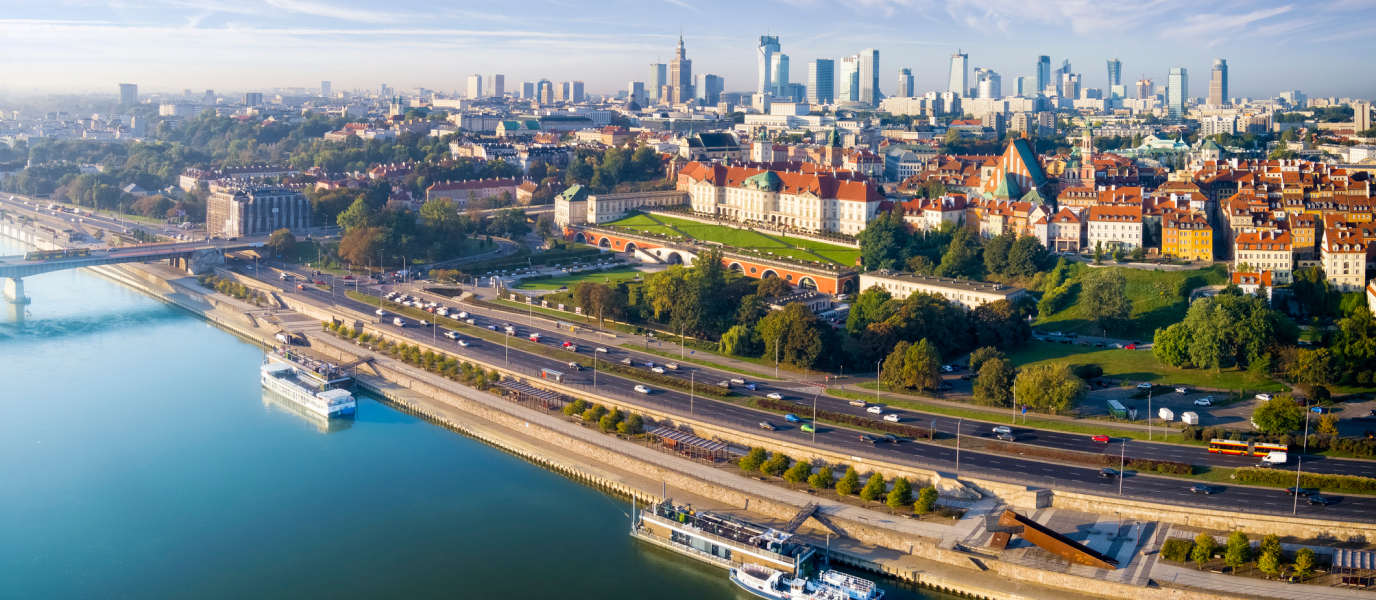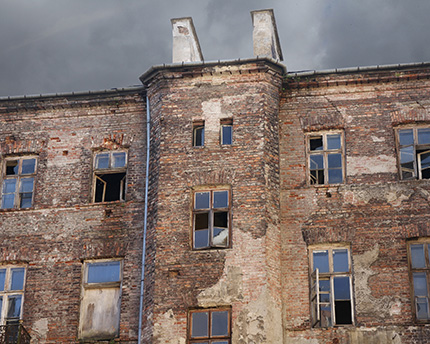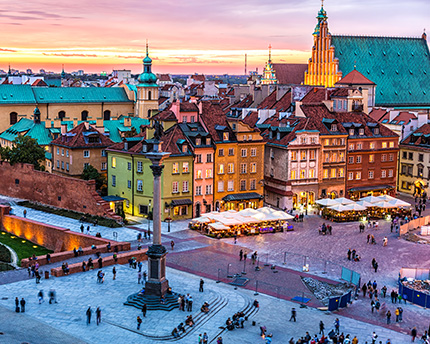Considered one of Warsaw’s star tourist attractions, the Royal Castle’s history is a rich and eventful one. So much has happened since the original Royal Castle was built in the late fourteenth century on the orders of the Dukes of Masovia. Many monarchs and state rulers have passed through its rooms. Then, in 1944, the Royal Castle was completely destroyed on the orders of Hitler. No one could have foretold that this edifice, the symbol of Poland’s independence, would be restored in 1971, thanks to the enthusiasm of the Polish people and to the many donations received from throughout the country and even from abroad.
Today, the castle houses the Polish Foundation for History and Culture and the Royal Castle of Warsaw Museum. Over thirty of their rooms, all richly decorated, are open to the public. Visitors can see the Parliamentary Chambers and the splendid royal apartments, adorned with valuable paintings and eighteenth-century sculptures. Special mention should be given to the Canaletto Room, with its views of Warsaw painted by the famous Venetian artist’s nephew. Interestingly, the architects who rebuilt the city of Warsaw after the Second World War took inspiration from these scenes.
The history of the Royal Castle
As might be expected of such an old building, Warsaw’s Royal Castle has been extended and remodelled several times. It originated in the fourteenth century as the Grand Tower, built on the orders of the Dukes of Masovia, and was then enlarged by Janusz I, the Prince of Masovia, during the fifteenth century. Still in existence from that time are the domed cellars that were apparently used to store the royal treasures. Soon afterwards, the castle was extended to accommodate the General Diet, which governed both Poland and Lithuania.
Early in the seventeenth century, the castle was extended again, designed by Italian artists, and took on its definitive form. During the Vasa reign, the castle was one of the most elegant in Europe, but its great splendour was short lived, as the Swedes seriously damaged the building in their quest to take the city.
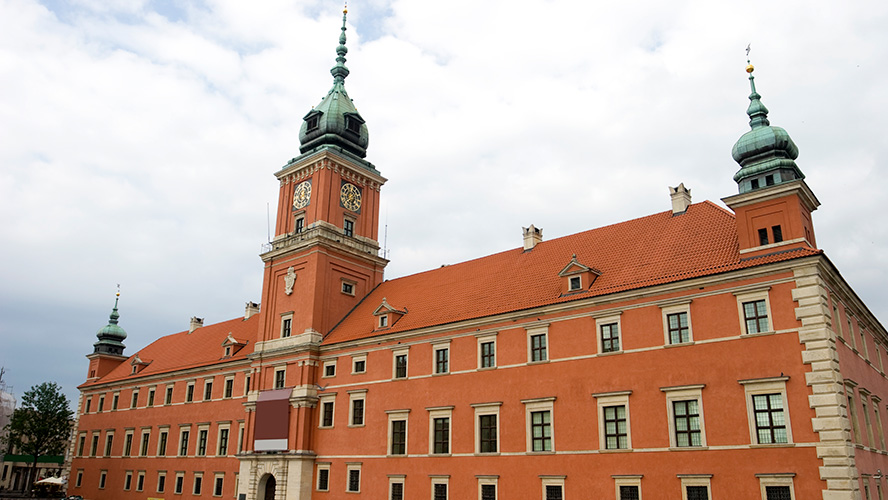
The so-called Royal Apartments (including the Canaletto Room and the Old Audience Chamber) were designed during the eighteenth century. After the abdication of King Stanislaw August, the building was left abandoned. On the declaration of the Republic of Poland in 1918, the castle became the presidential residence.
The Royal Castle suffered its worst misfortunes during the time of the Nazis, who attempted to demolish the building (unsuccessfully) in 1939, but then succeeded in 1944. The decision to reconstruct the building was taken in 1971. Now the castle is restored to its former glory, and those furnishings that could be salvaged after the War have been returned to its rooms.
Inside the castle. What you will see on your visit
Several rooms are open to the public at this former seat of the Polish monarchy. Visitors can see the Royal Apartments and the Throne Room. They can also view the original paintings by Rembrandt and those by Bernardo Bellotto — also known as Canaletto the Younger, the nephew of the renowned Venetian painter. Also open to the public is the Senators’ Chamber. It was in this room that the 3rd of May Constitution was enacted, the first Magna Carta in Europe and the second one in the world. It is also worth visiting the gardens, which are a veritable oasis of peace. There are flowerbeds, fountains, mazes with hedges several metres tall, and an extensive lawned area.
Architecture
Constructed mainly in brick in a Baroque-Neo-Classical style, the Royal Castle comprises a main building, which is virtually rectangular and built around a central courtyard. It has three storeys and an attic, and its façade is quite plain. The outstanding feature is the 60-metre-tall Clock Tower, with its green cupola. The façade overlooking the gardens and the river Vistula is in three sections, two of which have arches on the ground floor and a pediment with mid-relief carvings representing two angels with flutes holding up the crown and insignia of the Polish monarchy.
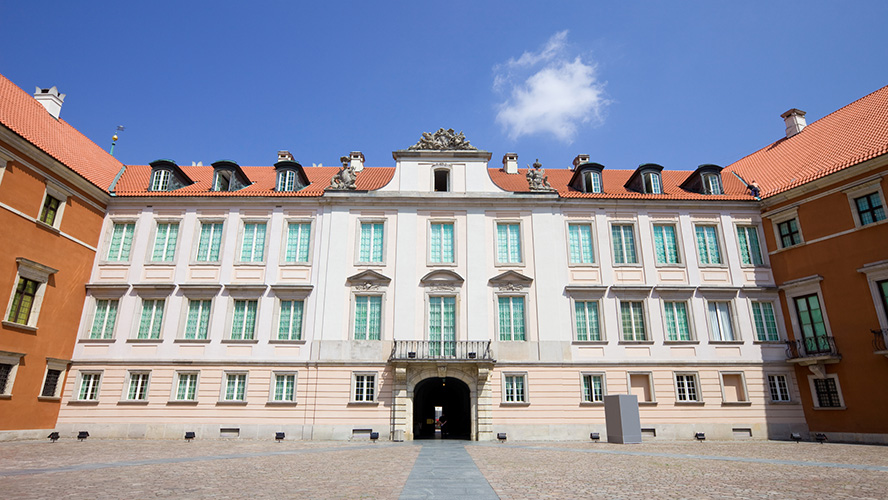
Information for visitors (opening hours, prices, and so on.)
Warsaw’s Royal Castle stands in the oldest part of the city. It is open to the public from May until September, 10.00 a.m. – 6.00 p.m. — except Thursdays (opening hours 10.00 a.m. – 8.00 p.m.) and Sundays (11.00 a.m. – 6.00 p.m.). During the rest of the year, it is open from Tuesday to Saturday, 10.00 a.m. – 4.00 p.m. and on Sundays, 11.00 – 4.00 p.m.
Admission prices vary depending on which parts of the castle you wish to visit. Reductions and family tickets are available. Admission is free with a Warsaw Pass.
Where to stay in Warsaw
If you’re looking for a comfortable stay enjoying Warsaw’s heritage and unique character, we can heartily recommend the Hotel Barceló Warsaw Powisle, located in the heart of the vibrant Powisle district. This is a unique establishment, housed in a former electricity power station, which gives it an industrial vibe and a great deal of character, so that guests enjoy a once-in-a-lifetime experience.
The hotel has 151 rooms offering every kind of comfort and convenience. The rooms are thoughtfully designed and decorated with elements from the old power station: large-scale pipework, control units, and industrial elegance. That is how new and old blend harmoniously in this remarkable hotel. The hotel also has a main restaurant with a great range of cuisine, in addition to a lobby bar and a sky bar with an outdoor swimming pool, depending on the season. And for those who like to keep in shape, there is a fully equipped gymnasium. This, in a nutshell, is a flagship of design and gastronomy. It is certain to provide an unforgettable experience.






























































